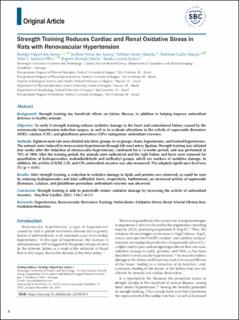| dc.contributor.author | Miguel dos Santos, Rodrigo | |
| dc.contributor.author | Dos Santos, Jucilene Freitas | |
| dc.contributor.author | Macedo, Fabricio Nunes | |
| dc.contributor.author | Marçal, Anderson Carlos | |
| dc.contributor.author | Santana-Filho, Valter J. | |
| dc.contributor.author | Wichi, Rogerio Brandão | |
| dc.contributor.author | Lauton-Santos, Sandra | |
| dc.date.accessioned | 2023-01-13T10:29:07Z | |
| dc.date.available | 2023-01-13T10:29:07Z | |
| dc.date.created | 2021-11-26T10:28:26Z | |
| dc.date.issued | 2021 | |
| dc.identifier.citation | Arquivos Brasileiros de Cardiologia. 2021, 116 (1), 4-11. | en_US |
| dc.identifier.issn | 0066-782X | |
| dc.identifier.uri | https://hdl.handle.net/11250/3043315 | |
| dc.description.abstract | Background
Strength training has beneficial effects on kidney disease, in addition to helping improve antioxidant defenses in healthy animals.
Objective
To verify if strength training reduces oxidative damage to the heart and contralateral kidney caused by the renovascular hypertension induction surgery, as well as to evaluate alterations in the activity of superoxide dismutase (SOD), catalase (CAT), and glutathione peroxidase (GPx) endogenous antioxidant enzymes.
Methods
Eighteen male rats were divided into three groups (n=6/group): sham, hypertensive, and trained hypertensive. The animals were induced to renovascular hypertension through left renal artery ligation. Strength training was initiated four weeks after the induction of renovascular hypertension, continued for a 12-weeks period, and was performed at 70% of 1RM. After the training period, the animals were euthanized and the right kidney and heart were removed for quantitation of hydroperoxides, malondialdehyde and sulfhydryl groups, which are markers of oxidative damage. In addition, the activity of SOD, CAT, and GPx antioxidant enzymes was also measured. The adopted significance level was 5% (p < 0.05).
Results
After strength training, a reduction in oxidative damage to lipids and proteins was observed, as could be seen by reducing hydroperoxides and total sulfhydryl levels, respectively. Furthermore, an increased activity of superoxide dismutase, catalase, and glutathione peroxidase antioxidant enzymes was observed.
Conclusion
Strength training is able to potentially reduce oxidative damage by increasing the activity of antioxidant enzymes. (Arq Bras Cardiol. 2021; 116(1):4-11) | en_US |
| dc.language.iso | eng | en_US |
| dc.publisher | Brazilian Society of Cardiology | en_US |
| dc.rights | Navngivelse 4.0 Internasjonal | * |
| dc.rights.uri | http://creativecommons.org/licenses/by/4.0/deed.no | * |
| dc.title | Strength training reduces cardiac and renal oxidative stress in rats with Renovascular hypertension | en_US |
| dc.title.alternative | Strength training reduces cardiac and renal oxidative stress in rats with Renovascular hypertension | en_US |
| dc.type | Peer reviewed | en_US |
| dc.type | Journal article | en_US |
| dc.description.version | publishedVersion | en_US |
| dc.source.pagenumber | 4-11 | en_US |
| dc.source.volume | 116 | en_US |
| dc.source.journal | Arquivos Brasileiros de Cardiologia | en_US |
| dc.source.issue | 1 | en_US |
| dc.identifier.doi | 10.36660/abc.20190391 | |
| dc.identifier.cristin | 1959583 | |
| cristin.ispublished | true | |
| cristin.fulltext | original | |
| cristin.qualitycode | 1 | |

